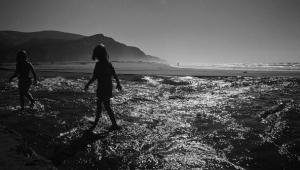Interesting that nobody mentioned the killer. (Assuming that this wasn't an accident.) For arguments' sake, if we assume that the photographer could have done nothing to prevent the death: What could / should the photographer have done to capture an image of the perpetrator? It isn't an easy question, if it was a 'mob hit' taking the photograph of the killer could put the photographer at risk. I would take the picture if I had the opportunity; I don't recommend this to others, nor do I recommend not taking the picture.
Chris
To Photograph, or Not to Photograph: That is the Question.
The victim, 58-year-old Ki Suk Han, was pronounced dead at a local hospital a short while later. The photographer, R. Umar Abbasi, said he began firing his camera in the hope his electronic flash would alert the train’s driver to the impending calamity.
Numerous questions arose after the incident: Could Abbasi or shocked bystanders have pulled Han to safety? Was the photographer really trying to warn the train’s operator or was he simply trying to “get the shot?” Should he have made the photo available for public consumption? Should the Post have published the image?
A day after the tragedy Cord Jefferson of gawker.com interviewed a number of professional photojournalists to get their take on the controversy. Here are a few of the responses he received:
Vincent Laforet, Pulitzer Prize winner for feature photography:
“If Mr. Abbasi felt he could not physically make it to the man trapped on the tracks in time—firing his flash to get the operator’s attention may have been his only recourse. Most photojournalists decide they are human beings first and will do anything they can to save another at the expense of making a photograph. Things become very difficult when you know that you either a) don’t have the proper training or equipment to help/rescue another person, b) the necessary time, or c) that you will likely become a second victim that needs to be rescued or worse.”
Ross Taylor, staff photographer for the Virginian-Pilot:
“I would not have run the image as the Post did on the front cover. If it was a major news event, one that warranted a need for such a display, that would have been one thing. In my opinion, this was not a major news event and I don’t think it was the right call.”
John Kaplan, Pulitzer Prize winner for feature photography:
“In truth, nobody can say whether the photographer could have safely rescued the victim. The blame in this controversy lies directly with the NY Post for publishing such a callous, crude and truly tasteless headline while at the same time wrongly splashing the tragedy on the front page.”
Roy S. Gutterman, associate professor of communications law and director of the Tully Center for Free Speech at Syracuse University:
“Once a reporter or photographer lends a hand to someone, that journalist ceases being a journalist and becomes part of the story. There’s no way to maintain the independence as a journalist and participate in a news event at the same time. I’m not sure the photographer in this case could have taken the dramatic picture and saved the guy at the same time, both practically and ethically.
John Freeman, associate professor of Journalism, University of Florida:
“I must assume the photographer believed that taking the photo would alert the train driver enough to stop. I doubt any working photojournalist would knowingly choose to photograph a scene anticipating death or injury of a subject unless they felt there was nothing they could do to help. I understand the public outcry. I can only imagine the photographer’s angst. There are no winners: there is a poor man who lost his life, a train driver that killed a person, and a photographer who witnessed it all.”
- Log in or register to post comments













































